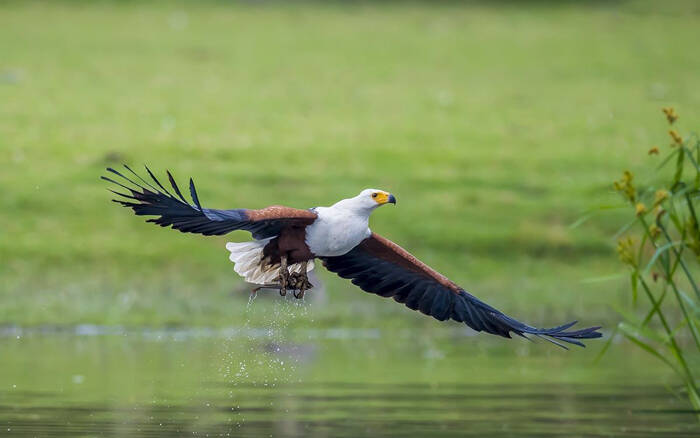Icthyophaga humilis
IUCN
LCBasic Information
Scientific classification
- name:Icthyophaga humilis
- Scientific Name:Icthyophaga humilis,Lesser Fish-eagle,Small fish sculpture,Haliaeetus humilis (Müller & Schlegel, 1841),Pigarguillo Menor,Falco humilis Muller & Schlegel, 1841,Ichthyophaga humilis (Müller &am
- Outline:Raptor
- Family:Accipitridae S.Eagles Genus
Vital signs
- length:61-69cm
- Weight:1.5-2.8kg
- lifetime:20-70years
Feature
The soles of the feet are covered with spicules that are as rough as sandpaper
Distribution and Habitat
Distributed in India (restricted to the Himalayan foothills and northeast, with smaller numbers in southern Karnataka, declining in range and abundance), Bangladesh, Nepal (rare), Bhutan (very rare at low altitudes), China (rare on Hainan Island, wandering), Myanmar (widespread, fairly common locally), Thailand (rare in the west and south), Cambodia, Laos (small numbers persist, though scattered and small in distribution, making them vulnerable to local extinction), Vietnam (rare in the northwest and southern Annam, fairly common elsewhere), Peninsular Malaysia (once common, fairly common locally but declining in abundance) and East Malaysia, Brunei (scarce), Indonesia (uncommon in Sumatra and Borneo, common in southeastern Sulawesi, uncommon elsewhere, found in the Sula Islands and Buru Island).
The fishing eagle is a forest-dwelling bird of prey that lives along rivers and streams in montane forests and occasionally in montane lakes at altitudes of around 2,000 m. [3] It inhabits
Appearance
The wings of the fishing eagle are broad and blunt, and the legs are thick and featherless. Like related species of the genus Erythrus, the soles of the feet are covered in spicules that are as rough as sandpaper to help grip slippery fish. The claws are long, slender, sharp and curved, also useful for catching fish.
The head and neck are gray, with slight black feather rachis patterns, and the feather rachis patterns are more obvious in old birds. The rest of the underparts are grayish brown or dark brown, and the bases of the inner wings of the primary flight feathers are often more or less dotted with white spots. The tail is round, the central tailfeathers are grayish brown, with light tips and broad black subterminal spots, and the base of the outer tailfeathers is 2/3 Marked with white and brown markings; 1/3 ends black. In older birds, this white spot disappears, and the front neck and chest are grey-brown, and the belly and flanks, as well as the anal area, lower tail covert
Details
Lesser Fish-eagle, also known as the Lesser Fish-eagle, is a large bird of prey with no subspecies.

The Lesser Fish-eagle is an occasional winter migratory bird in China. It likes to stay on big trees or rocks. Its "ah, ah" cry is very loud. It feeds almost entirely on fish, and only occasionally eats some reptiles and other animals. When hunting, the fishing eagle does not take the approach of swooping into the water from the air as other eagles and ospreys do, but quietly stands on a tree by the water and waits for the opportunity. Once it finds a fish swimming near the water, it quietly glides down from the tree where it lives, flies at high speed close to the water surface, and then quickly stretches out its claws to grab the fish without splashing the water surface. It appears to be very fast and calm, and can be said to be elusive. If there are fewer fish near the water surface, it can also dive into the water to hunt. It mainly feeds on fish, and occasionally eats reptiles.
The fishing eagle breeds in mountain forest areas below 2,000 meters, nesting in tall trees on both sides of rivers in the forest, and occasionally in isolated trees in farmlands and grasslands at the foot of the mountain. The breeding season is from March to June, with egg laying starting in March, with 2-3 eggs per clutch. The egg size is 64.6 mm × 20.1 mm. The chicks are raised by both the male and female birds.
The global population of the fishing eagle is preliminarily estimated at 10,000-50,000 mature individuals, pending further research. This is equivalent to a total of approximately 15,000-75,000 individuals.
It is already rare throughout its distribution range, especially on the Indian subcontinent, mainly due to loss of forest habitat along rivers, siltation, overfishing, increased human interference with waterways, and direct hunting. The fishing eagle is also clearly susceptible to human use of pesticides, which causes thinning of the eggshell, making it difficult to raise chicks. Based on the rate of habitat loss and degradation, it is suspected that the species is in a moderately rapid and ongoing decline.
Listed in the IUCN Red List of Threatened Species in 2016 ver3.1 - Near Threatened (NT).
Listed in Appendix I, II and III of the Convention on International Trade in Endangered Species of Wild Fauna and Flora (CITES) 2019 edition Appendix II.
Listed in China's National List of Key Protected Wildlife (February 5, 2021) at level II.
Protect wildlife and eliminate game.
Maintaining ecological balance is everyone's responsibility!








